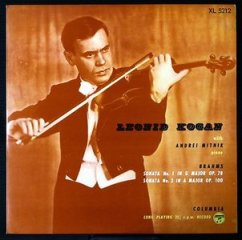The Art Of Leonid Kogan (2014) CD2 - Brahms Violin Sonata No.1 & 2
The Art Of Leonid Kogan (2014) CD2 - Brahms Violin Sonata No.1 & 2

1. Brahms - Violin Sonata No.1 in G, Op.78, I. Vivace ma non troppo (9:22) 2. Brahms - Violin Sonata No.1 in G, Op.78, II. Adagio (7:33) 3. Brahms - Violin Sonata No.1 in G, Op.78, III. Allegro molto moderato (8:16) 4. Brahms - Violin Sonata No.2 in A, Op.100, I. Allegro amabile (7:25) 5. Brahms - Violin Sonata No.2 in A, Op.100, II. Andante tranquillo (6:07) 6. Brahms - Violin Sonata No.2 in A, Op.100, III. Allegretto grazioso (4:52) Leonid Kogan (violin) Andrei Mytnik (piano)
Brahms-Kogan generally spells the violin concerto. The Mytnik-accompanied sonata recordings are less often encountered though still not rare. The Kogan-Mytnik was a real duo not a chauffeur and master arrangement. Despite the fact that Mytnik is naturally not as well remembered as his illustrious partner he makes for an assertive and combative presence, all to the good for ensemble work. Their collective expressive control is always impressive, Kogan’s multi-faceted command of style and timbre proving intensely moving in the finale of the First Sonata – as it often is not.
The tempo for the sonata in A is just right and the amabile is perfectly conveyed. Kogan heightens feeling through the subtlest use of portamento and colour: the intensification of vibrato in which he engages in the finale is of an exalted kind, and the lyrical beauty he finds is wondrous. --- Jonathan Woolf, musicweb-international.com
Written in Portschach in southern Austria in the summers of 1878 and 1879, the Sonata in G Major chronologically follows the Violin Concerto, Op. 77, one of the best-loved works in the violin literature. This sonata is reputed to be the composer's third or even possibly the fifth attempt at writing a violin sonata. Brahms had written a "Scherzo" movement in 1853, as a birthday tribute to the violinist Joseph Joachim which became a part of the F.A.E. Sonata. This piece was a joint effort with Schumann and Albert Dietrich. Sometime between then and 1878, Brahms tried composing a number of works for violin and piano, but none has survived.
The Sonata in G Major is a three-movement work containing fragmentary references in the first and last movements to two of Brahms's earlier songs, Regenlied and Nachklang op.59, No.3 and 4, respectively, of 1873. Set to poems by his friend Klaus Groth, they incorporate rain in a symbolic and poetic manner. In the first poem, the rain awakens dreams of childhood, and would "bedew my soul with innocent childish awe" and in the second, raindrops and tears mingle, so that when the sun shines again, "the grass is doubly green: doubly on my cheeks glow my burning tears." This is not to say that this piece is "program" music; however it gives us possible insight into Brahms's psyche, as well as that of the performer and the listener, as the piece unfolds. --- Midori, gotomidori.com
While on vacation in Thun during August 1886, Johannes Brahms found himself so refreshed and musically invigorated that he proclaimed the area to be "so full of melodies that one has to be careful not to step on any." Indeed, during his time there Brahms composed three of his most beloved chamber works in just a matter of days. Op. 99 is the second of Brahms' two cello sonatas, and Op. 101 the great C minor piano trio; in between these is Op. 100, the Sonata for piano and violin No. 2 in A major (the order in which the instruments are listed -- piano first and then violin -- is Brahms' own indication; he was following in the footsteps of Mozart and Beethoven by giving the keyboardist top billing). The Sonata was premiered in Vienna a few weeks before Christmas 1886 by Brahms and then-famous violinist Joseph Hellmesberger.
The A major Sonata is both the shortest and the most immediately ingratiating of Brahms' three violin sonatas; not for a single moment is the radiant, happy mood ever put in real jeopardy (even during the fractured contrapuntal passages in the first movement's development), and the tunes are of the long-spun, heart-warming variety that sticks in the mind's ear. Brahms achieves a three-movement plan by combining slow movement and scherzo into one -- in this central movement, passages of sweet and simple Andante tranquillo alternate with fleet-footed Vivace episodes during which Brahms introduces hemiola and off-beat rhythmic accents. The Allegro amabile first movement is aptly summed up by that word, "amabile" -- one hardly expects that the second theme could possibly outdo the first in terms of sheer lyric beauty, but somehow Brahms manages it. In the Allegro grazioso (quasi Andante) last movement Brahms builds a relaxed rondo around a main theme whose contours are so deep and velvety that it has become customary for violinists to play the entire theme on the instrument's rich G string. --- Blair Johnston, Rovi
download (mp3 @320 kbs):
yandex 4shared mega mediafire zalivalka cloudmailru oboom uplea








